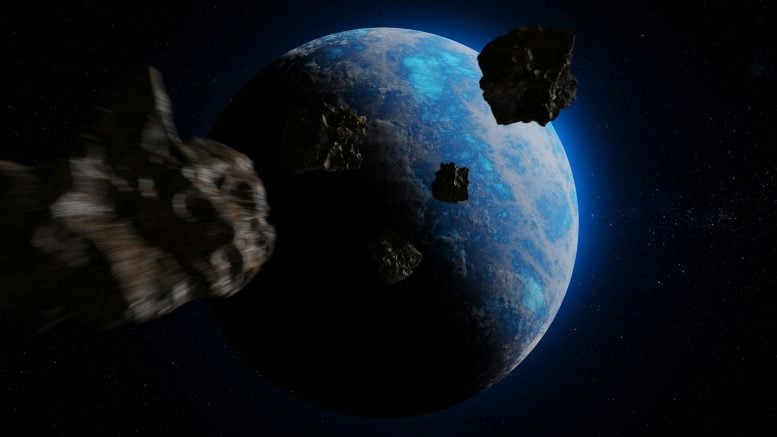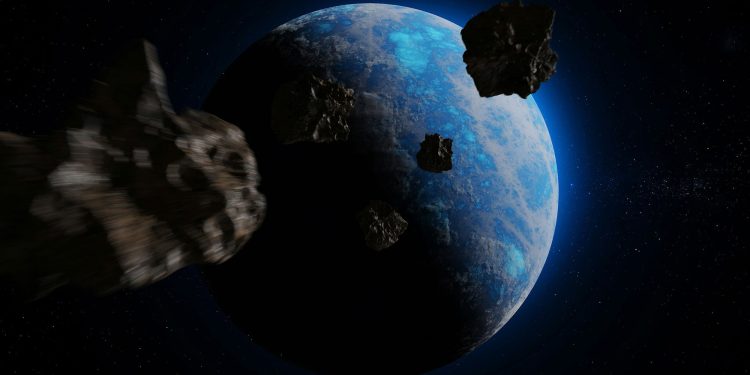
The Silverpit crater was confirmed as an asteroid impact site. Shocked crystals and seismic data prove that the event has created a huge tsunami.
For decades, scientists have debated the origin of the Silverpit crater in the south of the North Sea.
New evidence now shows that the structure was created by the impact of an asteroid or a comet about 43 to 46 million years ago.
The research team, led by Dr. Uisdean Nicholson of Heriot-Watt University in Edinburgh and supported by the Natural Environment Research Council (NERC), combined seismic imagery, microscopic study of rock cuttings and digital modeling to produce the most convincing case to this day that Silverpit is a real impact crater.
Their results were recently published in the journal Nature communications.
New data ends long -standing controversy
The Silverpit crater is 700 meters (2,300 feet) under the seabed of the North Sea, about 80 miles from the Yorkshire coast.
Since its discovery in 2002, the characteristic of three kilometers wide (1.8 thousand) – has shown a ring 20 kilometers wide (12.5 miles) of circular faults – has been at the center of an intense geological debate.
The first studies favored the idea that it was formed by an impact, pointing to its central peak, its circular outline and its concentric flaws, all the typical features of high -speed collisions.
https://www.youtube.com/watch?v=nyrixcfjba
However, other researchers have proposed alternative explanations, which suggests that the shape of the crater could have resulted from the movement of salt deeply below the surface or the collapse of the seabed caused by volcanic processes.
In 2009, the discussion had become so controversial that geologists voted informally on the issue, as indicated in the December issue of Geoscientific magazine. The majority at the time rejected the impact hypothesis.
New evidence has proven them.
An asteroid 160 m wide struck the North Sea
The team led by Heeriot-Watt used newly available seismic imaging data and evidence below the seabed to prove the theory of impact.
Dr. Uisdean Nicholson, sedimentologist of the energy school, geoscience, infrastructure and society of Heriot-Watt, said: “A new seismic imagery has given us an unprecedented look at the crater.
“Samples of an oil well in the region also revealed rare quartz and feldspath crystals” shocked “at the same depth as the crater floor.
“We were exceptionally lucky to find them – a real effort of” the needle in a haystack. These prove the hypothesis of the impact crater beyond doubt, because they have a fabric which can only be created by extreme shock pressures. »»
Tsunami 100 meters high
Dr. Nicholson said: “Our proof shows that an asteroid 160 meters wide (530 feet) struck the seabed at a low west angle.
“In a few minutes, he created a curtain of 1.5 kilometer (0.9 thousand) of rock and water which then collapsed in the sea, creating a tsunami of more than 100 meters (330 feet) high.”
Find “the silver ball”
Professor Gareth Collins de Imperial College London was at the debate of the Silverpit crater in 2009 and also provided digital models for the new study.
Professor Collins said: “I have always thought that the impact hypothesis was the simplest and most consistent explanation with observations.
“It is very rewarding to have finally found the miracle solution. We can now continue the exciting work to use the new incredible data to learn more about the impacts shape the planets below the surface, which is really difficult to do on other planets.”
Rare and exceptionally preserved
Dr. Nicholson said: “Silverpit is an impact crater of rare and exceptionally preserved hypervelocity.
“These are rare because the earth is such a dynamic planet – plates tectonics and erosion destroy almost all traces of most of these events.
“About 200 confirmed impact craters exist on land, and only about 33 were identified under the ocean.
“We can use these results to understand how the impacts of asteroids have shaped our planet through history, as well as to predict what could happen if we have an asteroid collision in the future.”
The confirmation of Silverpit as an impact crater places it alongside structures such as chicxulub crater in Mexico – linked to mass extinction of dinosaurs – and Nadir Crater off West Africa, which has recently been confirmed as an impact site.
Reference: “Multiple lines of evidence for an origin of impact of hypervelocity for the Silverpit crater” by Uisdean Nicholson, Iain de Jonge-Anderson, Alex Gillespie, Thomas Kenkmann, Tom Dunkley Jones, Gareth S. Collins, James Frankel, Veronica Bray, Sean Ps Gulick and Ronnie Parr, September 20, 2025 Bray, Sean Ps Gulick and Ronnie Parr, September 20, 2025, Nature communications.
DOI: 10.1038 / S41467-025-63985-Z
The research was funded by the Natural Environment Research Council (NERC), the complete details of the project are available online.
Never miss a breakthrough: join the Scitechdaily newsletter.
Follow us on Google, Discover and News.









